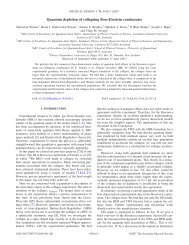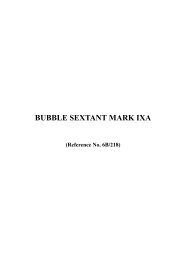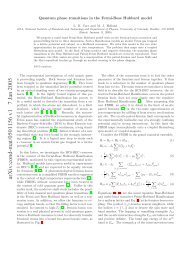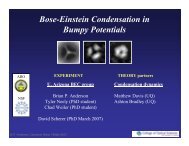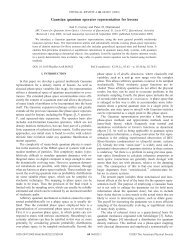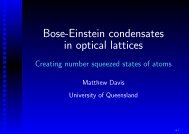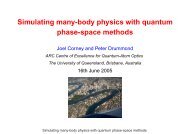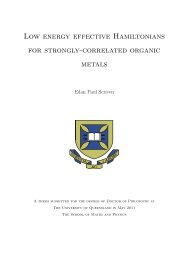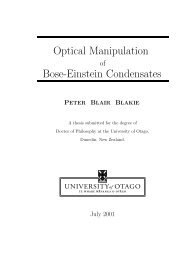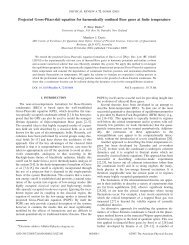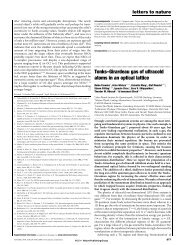Open Quantum Dynamics of Mesoscopic Bose-Einstein ... - Physics
Open Quantum Dynamics of Mesoscopic Bose-Einstein ... - Physics
Open Quantum Dynamics of Mesoscopic Bose-Einstein ... - Physics
Create successful ePaper yourself
Turn your PDF publications into a flip-book with our unique Google optimized e-Paper software.
4. Continuously monitored <strong>Bose</strong> condensates: quasiprobability distributionsdistribution remains symmetric about the equator <strong>of</strong> the Bloch sphere, and its behaviouris similar to the previous strong measurement simulations with ∣ ∣ j, 0〉xas the initial state(Fig. 4.2): it periodically splits into two components which move apart, sometimes movingover the poles to come down along a different longitude, which corresponds to the phasejumps in the tunnelling oscillations.When subcritical atom-atom interactions are included (Θ < 1), the Q function evolutionis very similar to the noninteracting case: the distribution gradually moves <strong>of</strong>f thesouth pole <strong>of</strong> the Bloch sphere, remaining compact as it precesses around the Ĵz axis. Forvery strong self-interactions (as in Fig. 4.11, where Θ = 2.0), the Q function develops therotating asymmetries, but it never (up to time t = 200t 0 ) fully moves <strong>of</strong>f the bottom <strong>of</strong>the sphere, leading only to oscillations <strong>of</strong> small amplitude.4.4 Quasiprobability distributions using optical coherent statesThe technique <strong>of</strong> mapping operator equations onto stochastic phase-space equations iscommon in quantum optics.Different phase-space representations are used to deriveFokker-Planck equations from the master equation. This technique is the basis <strong>of</strong> the secondpart <strong>of</strong> this thesis, in which quantum features are fully simulated by way <strong>of</strong> quasiprobabilitydistributions. Here we apply the technique to the conditional master equation (Eq.(3.21)) to get a probabilistic semiclassical description.Exactly what structure in Hilbert space is mapped onto the phase-space equationsdepends on what overcomplete set <strong>of</strong> states is used to represent ˆρ c . The most commonlyused states are the coherent states ∣ ∣ α〉<strong>of</strong> the boson field.They have the advantage<strong>of</strong> producing correspondences between the annihilation (and creation) operators and thephase-space variables that are simple in form 1 . The (conditional) Glauber-Sudarshan Pfunction is defined by∫ˆρ c =P (α) ∣ ∣ α〉〈α∣ ∣d 2 α, (4.18)1 For an overview <strong>of</strong> the properties <strong>of</strong> coherent states and the phase-space representations constructedfrom them, see the fourth chapter <strong>of</strong> [62]93



